Archaeology & History
11 of the Most Groundbreaking Discoveries of 2019, From the Priceless Painting in Grandma’s Kitchen to the Secret of Stonehenge
These were the year's biggest finds.
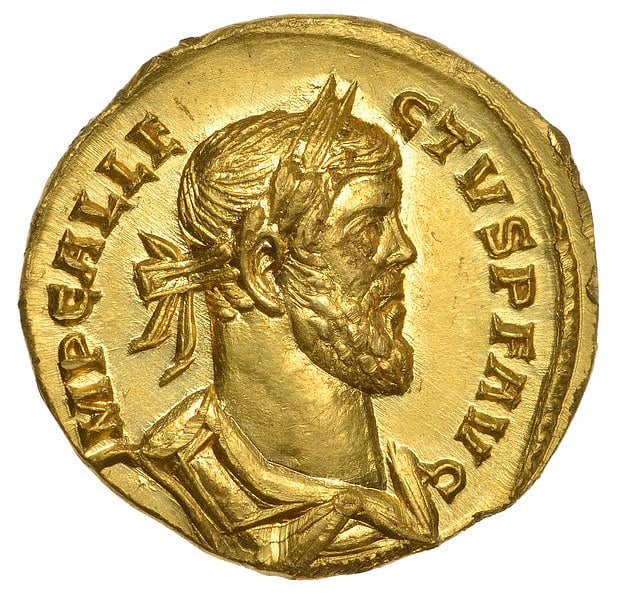
These were the year's biggest finds.

Sarah Cascone

As 2019 draws to a close, it’s time to once again revisit the year’s most exciting discoveries in art history and archaeology, from long-lost paintings to buried treasures and everything in between.
As always, some discoveries are the result of years, if not decades, of concerted research on the part of experts. Others are made by happenstance, such as a set of solid gold bands found by an amateur metal detectorist in the UK or an eagle-eyed 12-year-old who spotted an ancient mammoth tooth during a family gathering in the woods of Ohio.
Not all discoveries, of course, hold up to scrutiny. Some invite skepticism: The theory about Leonardo da Vinci’s only surviving sculpture has been floated for years; and claims to have decoded the mysterious Voynich manuscript have been floated for the second straight year—this time using an extinct language called proto-Romance—but were once again quickly called into question, leading the University of Bristol to retract its announcement about the paper.
But in many cases, the finds astonish and provide a greater understanding of human history and the world around us. So, without further ado, here are the biggest discoveries of 2019.
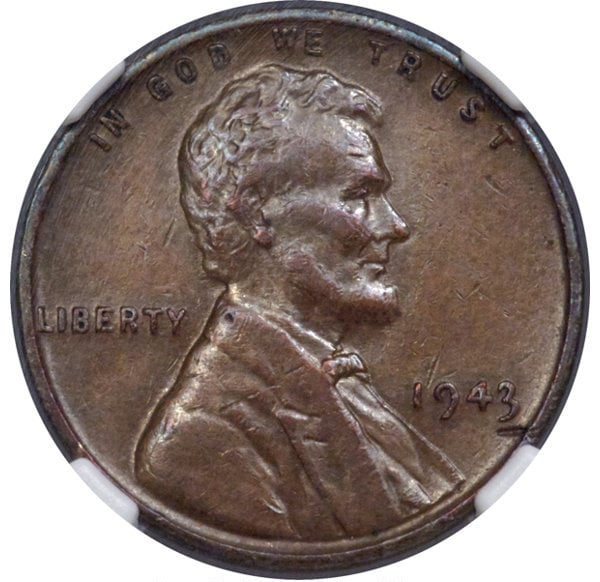
The penny! It’s worth a bundle. Photo: Heritage Auctions.
Even though he was just 16 at the time, Don Lutes Jr. knew there was something strange about the copper penny he received in a handful of change at the school cafeteria back in 1943. Turns out, it was one of just 20 copper pennies produced that year, the US Mint having switched to zinc-plated steel coins during wartime. Lutes died in 2018, but he’d had the coin authenticated in the 1950s. The world became aware of his amazing discovery in January, after his descendants sold it at auction for the impressive sum of $204,000.
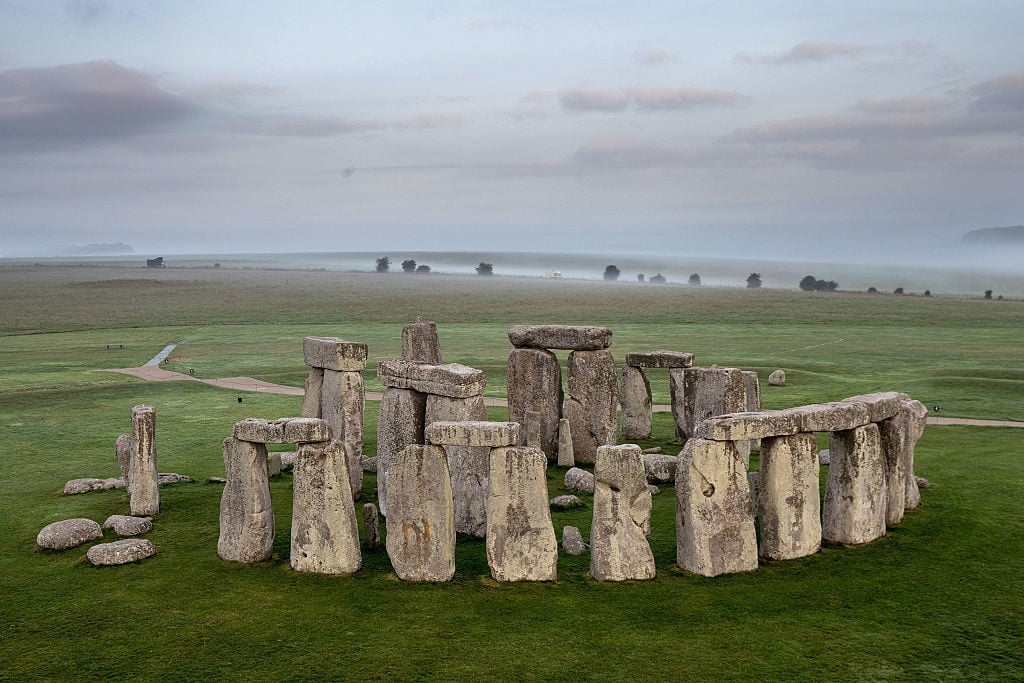
The inner rocks of Stonehenge may have been dragged nearly 150 miles from where they were quarried to their current site. Photo: Matt Cardy/Getty Images.
In February, a team of archaeologists claimed to have identified the exact quarries in the Preseli Hills in Wales that the “bluestone” dolerite rocks used in Stonehenge’s inner circle came from. It’s still unclear why the ancient builders would have moved the stone some 143 miles, but we do have a new hint as to how they achieved the monumental task of erecting the structure: using lard. Archaeologists now believe that antique jars with traces of lard found nearby suggest that animal fat was being used not just for cooking, but for construction purposes.
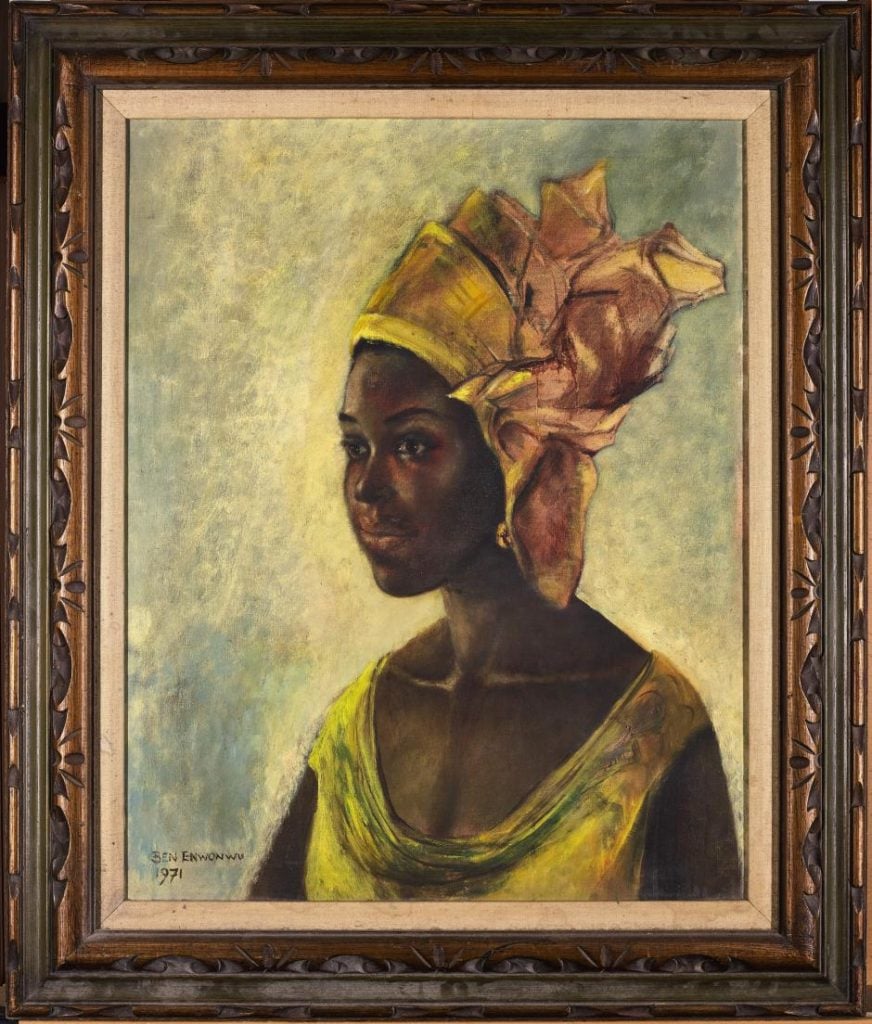
Ben Enwonwu, Christine (1971). Courtesy of Sotheby’s.
A Texas family never gave much thought to the portrait of the family matriarch that had decorated their home for decades. Then they Googled the artist, Ben Enwonwu, and discovered that he was a Nigerian Modernist art star who had recently made headlines for his rediscovered masterpiece of the Nigerian royal princess Adetutu Ademiluyi. When the family auctioned the painting at Sotheby’s London, it sold for £1.1 million ($1.4 million) despite a pre-sale estimate topping out at just £150,000 ($192,000).
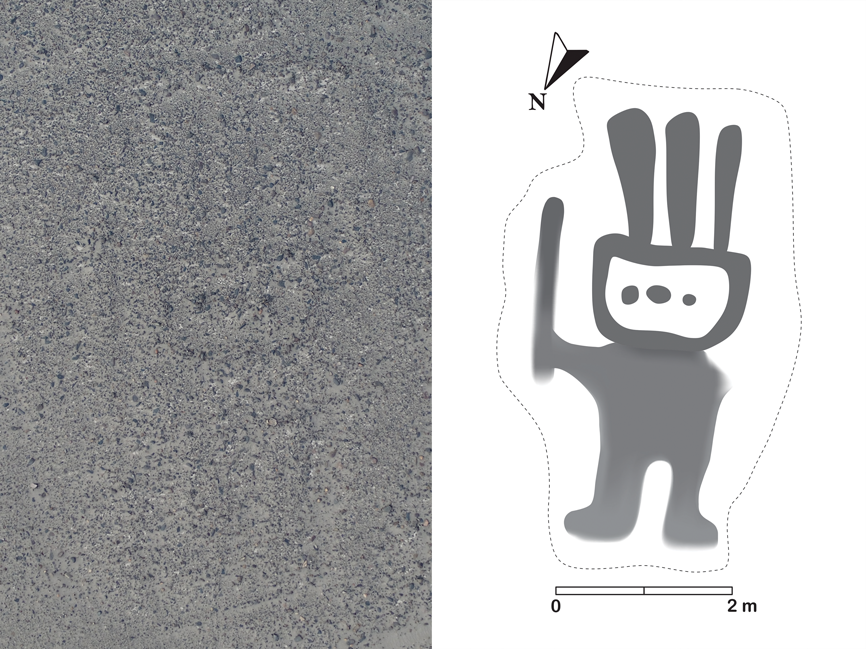
The original (left) and an A.I. rendering of a newly uncovered Nazca Line drawing in Peru.
Japan’s Yamagata University has been able to find 142 previously unknown Nasca Lines, giant earthwork drawings created in prehistoric Peru. To help find the faint lines, carved between 100 BC and 300 AD, the research group teamed up with IBM Japan to develop an A.I. model using the deep learning platform IBM Watson Machine Learning Community Edition. After analyzing the high-resolution aerial photos, A.I. added one new geoglyph to the project’s discoveries, for 143 examples of ancient Land art in total.

Traces of lapis lazuli were found in the dental tartar of a woman who lived at a 12th-century German monastery, leading researchers to believe she was a highly skilled artist who worked on illuminated manuscripts. Courtesy of Science Advances.
An investigation into monastic medieval diets sent researchers in an entirely unexpected direction when an archaeologist discovered visible traces of lapis lazuli in the dental tartar of a 10th- or 11th-century German nun. The working theory is that she was working with the expensive blue pigment to create a religious manuscript. Creating those colorful illuminations was a skill previously thought to be the exclusive purview of monks, but who knows how many of those anonymous medieval artists were actually women?

Gustav Klimt, Portrait of a Lady (c. 1916-17). Image courtesy Wikimedia Commons.
A gardener at the Ricci Oddi modern art gallery was stunned when he opened a metal panel on the back of the museum building, obscured by ivy vines, to discover a Gustav Klimt painting hidden inside. The work, Portrait of a Lady, was stolen back in 1997, its mysterious disappearance giving rise to all manner of conspiracy theories. Currently valued at €60 million ($66 million), the canvas may or may not have been on the premises the whole time.
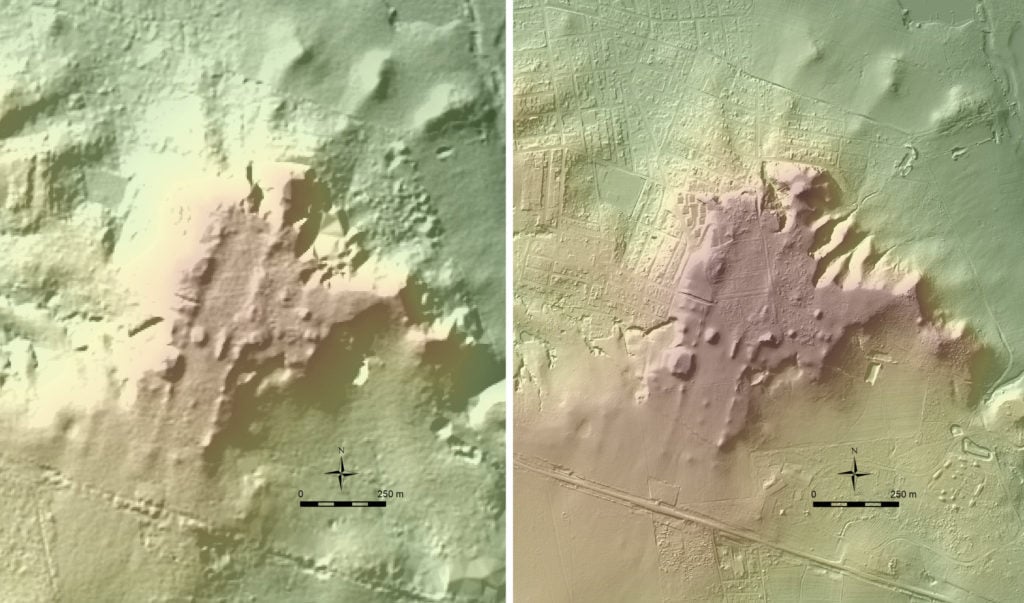
Takeshi Inomata identified this ancient Maya site, dubbed La Carmelita, using LiDAR maps, seen here in both low and high resolution. Image courtesy of the Instituto Nacional de Estadística y Geografía/Nacional Center for Airborne Laser Mapping.
Inspired by archaeologists in Guatemala who found thousands of Maya ruins thanks to light detection and ranging technology known as LiDAR—which involves airplanes equipped with laser mapping tools that take topographical readings of the landscape—a researcher at the University of Arizona looked at some old LiDAR maps published by the Mexican government in 2011. What he found were 27 unknown Mayan sites across 4,400 square miles of land, accomplishing decades-worth of groundtrooping remotely, without having to take a machete to dense jungle vegetation—further demonstrating just how revolutionary LiDAR is.

Cimabue, The Mocking of Christ. Photo courtesy ACTEON Senlis.
The owner, a little old lady in France, kept the small religious painting hanging above the hot plate in her kitchen. It was only when she called in an auction house to help sell some of her belongings that she discovered the piece was actually a missing panel from a well-known altarpiece by Cimabue—and worth many millions. Considered Italy’s first proto-Renaissance painter, Cimabue represents an important stepping stone between the Byzantine style of Italy’s medieval period and the greater realism of the 14th century. But the painting smashed expectations when it sold at auction in Paris for a record €24.2 million ($26.8 million).
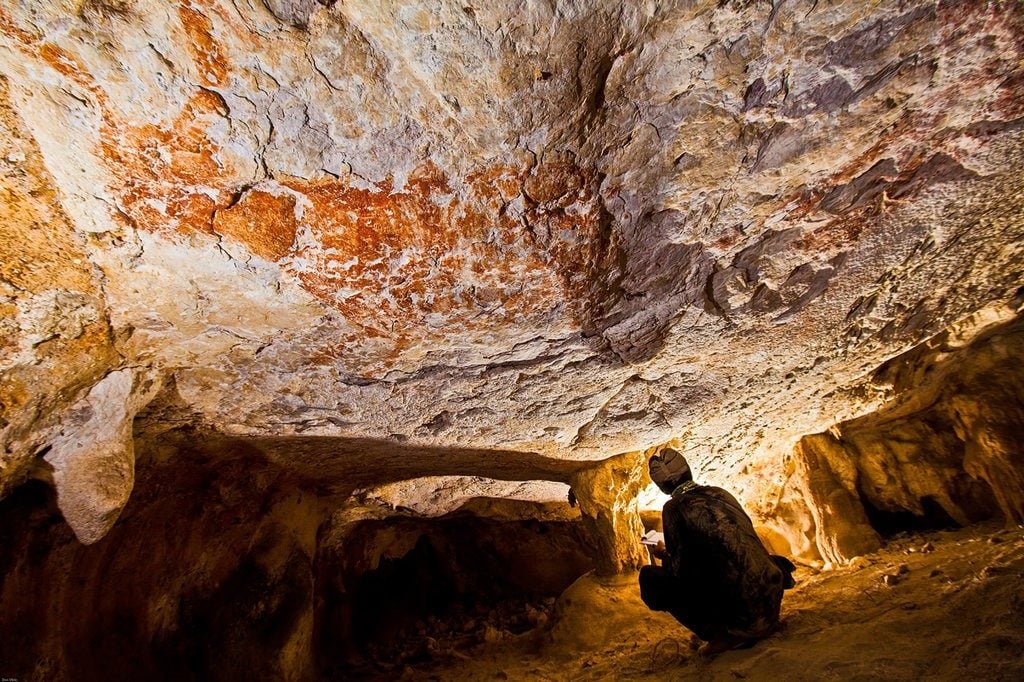
A researcher studying what was previously believed to be the world’s oldest figurative art in a Borneo cave. The find has been supplanted by a new discovery in Indonesia. Photo by Pindi Setiawan.
The oldest pictorial art in the world is now believed to be an ancient hunting scene painted on the walls of an Indonesian cave some 43,900 years ago. The prehistoric artwork is even more significant, however, because it shows imaginary figures with both human and animal features. That suggests that the concept of religious thinking originated not in Europe, as previously thought, but much earlier, and on the opposite side of the globe.
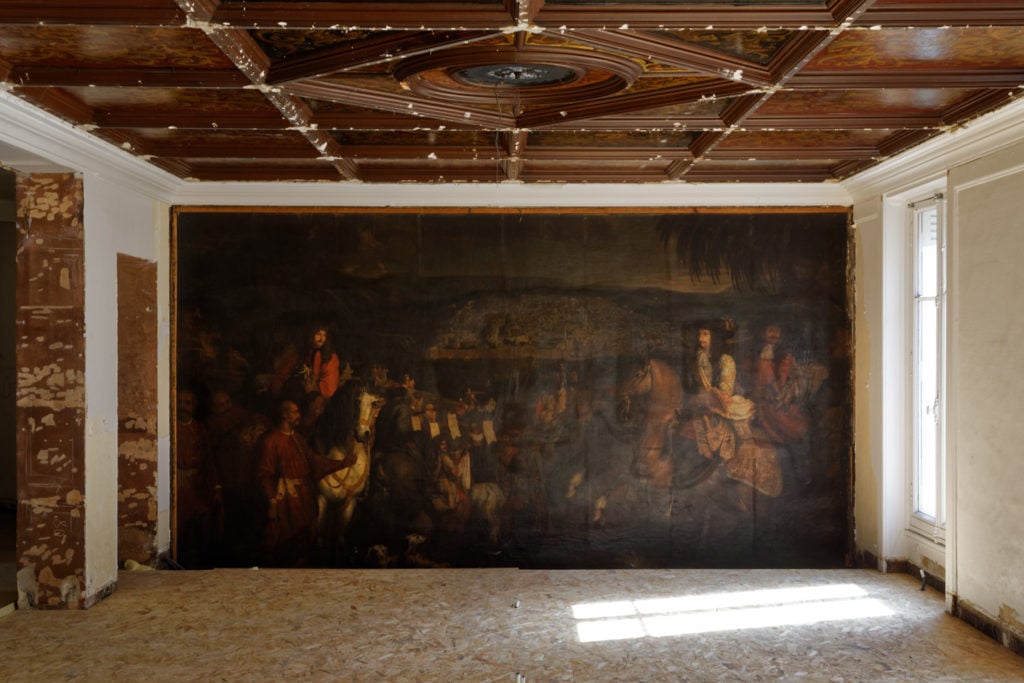
A work by Arnould de Vuez uncovered at 4, rue de Marignan, Paris. Photo courtesy of Oscar de la Renta.
Construction workers found the surprise of a lifetime when they encountered a 1674 painting by Arnould de Vuez, an artist in the court of Louis XIV, hidden behind a wall of a historic Paris building. The workmen were doing renovations ahead of the planned opening of an Oscar de la Renta fashion boutique, but quickly stopped to call in art historians. The painting, praised as an “inexplicable holy grail,” was carefully restored and can now be seen at the designer’s shop.
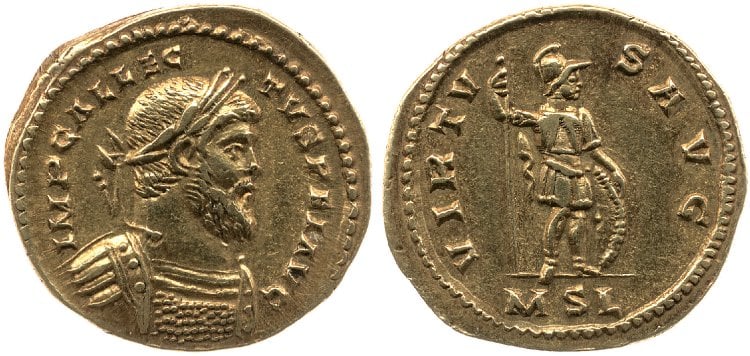
Golden aureus coin featuring a bust of Allectus, the Roman emperor who ruled Britain as an independent nation from 293 to 296 AD, during the time of the Roman Empire. Photo ©The Trustees of the British Museum.
Any metal detector enthusiast would be happy to stumble across a 24-carat gold coin, but a 1,700-year-old one found in a field in Kent, England, proved a particularly fascinating discovery. That’s because it features the Roman Emperor Allectus, who forced the “original” Brexit by breaking away from the Roman Empire and ruling Britannia and northern Gaul as an independent nation between 286 and 296 AD. At London auction house Dix Noonan Webb, it was expected to fetch no more than $127,000, but it sold for $700,000, becoming the most expensive Roman coin minted in Britain ever sold at auction.
Archaeologists Were Shocked to Find This Golden Pendant of an Ancient Egyptian Goddess—in Greece
An Ornate Shield Found in a Celtic Warrior’s Grave Is Challenging What We Know About Ancient Combat
Scientists Have Found the Rare Secret Ingredient Rembrandt Used to Make His Paintings So Vibrant
A Long-Lost Cupid Is Revealed Under the Surface of One of Vermeer’s Greatest Paintings